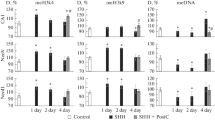Objective. To study changes in the level of DNA methylation in rat neocortex and hippocampus cells on exposure to different hypobaric hypoxia regimes. Materials and methods. Studies were performed on 24 adult male Wistar rats (180–200 g). Animals were subjected to hypobaric hypoxia in different regimes using a flow-type barochamber. Brain sections were used for immunohistochemical reactions for 5-methylcytidine in DNA. Changes in the total number of cells and their distribution into two classes based on the intensity of the immunohistochemical reaction for DNA 5-methylcytidine in neocortex and hippocampus were evaluated. Results. Presentation of severe harmful hypoxia (SHH) produced increases in the number of intensively immunopositive cells in the neocortex by 3 h after exposure. The prophylactic neuroprotective action of three (but not one) sessions of moderate hypobaric hypoxia (MHH) led to a reduction in the number of intensely immunopositive cells in the neocortex in response to subsequent SHH. No significant changes were seen in the hippocampus. Conclusions. Opposite changes were seen in the level of DNA methylation in the rat neocortex depending on the degree of hypobaric hypoxia: harmful SHH was linked with gene repression, while adaptogenic MHH produced gene activation.
Similar content being viewed by others
References
M. O. Samoilov and E. A. Rybnikova, “Molecular-cellular and hormonal mechanisms of induced tolerance of the brain to extreme environmental factors,” Ros. Fiziol. Zh., 98, No. 1, 108–126 (2012).
M. Endres, A. Meisel, D. Biniszkiewicz, et al., “DNA methyltransferase contributes to delayed ischemic brain injury,” J. Neurosci., 20, No. 9, 3175–3181 (2000).
S. Schweizer, A. Meisel, and S. Marschenz, “Epigenetic mechanisms in cerebral ischemia,” J. Cereb. Blood Flow Metab., 33, No. 9, 1335–1346 (2013).
R. People, Simon, “Epigenetic modulation of gene expression governs the brain’s response to injury,” Neurosci. Lett., 625, 16–19 (2016).
J. A. Watson, C. J. Watson, A. McCann, and J. Baugh, “Epigenetics, the epicenter of the hypoxic response,” Epigenetics, 5, No. 4, 293– 296 (2010).
Author information
Authors and Affiliations
Corresponding author
Additional information
Translated from Morfologiya, 155, No. 3 pp. 12–16, May–June, 2019.
Rights and permissions
About this article
Cite this article
Churilova, A.V., Glushchenko, T.S., Rybnikova, E.A. et al. Changes in the DNA Methylation Pattern on Formation of Adaptive and Pathological Responses of Telencephalon Neurons to Hypobaric Hypoxia. Neurosci Behav Physi 50, 388–391 (2020). https://doi.org/10.1007/s11055-020-00910-5
Received:
Revised:
Published:
Issue Date:
DOI: https://doi.org/10.1007/s11055-020-00910-5



